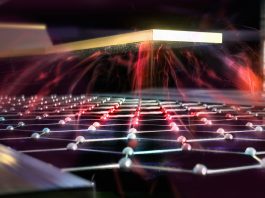A team of researchers in the UK have used light to detect quantum information stored in 100,000 nuclear quantum bits, bringing us one step closer to developing the quantum internet.
Researchers from the University of Cambridge have injected a ‘needle’ of highly fragile quantum information into a ‘haystack’ of 100,000 nuclei. Using lasers to control an electron, the researchers could then use that electron to control the behaviour of the haystack, making it easier to find the needle. They were able to detect the needle with a precision of 1.9 parts per million: high enough to detect a single quantum bit in this large ensemble.
As reported in the journal Nature Physics, this technique makes it possible to send highly fragile quantum information optically to a nuclear system for storage, and to verify its imprint with minimal disturbance, an important step in the development of a quantum internet based on quantum light sources.
In order to leverage the full potential of supercomputers, scientists must develop a quantum internet. Channels of light that transmit quantum information are promising candidates for a quantum internet, and currently there is no better quantum light source than the semiconductor quantum dot: tiny crystals that are essentially artificial atoms.
Maximising the storage capacity of quantum dots
One thing standing in the way of quantum dots and a quantum internet is the inability to store quantum information temporarily at staging posts along the network. Professor Mete Atatüre from Cambridge’s Cavendish Laboratory, who led the research, explained: “The solution to this problem is to store the fragile quantum information by hiding it in the cloud of 100,000 atomic nuclei that each quantum dot contains, like a needle in a haystack. But if we try to communicate with these nuclei like we communicate with bits, they tend to ‘flip’ randomly, creating a noisy system.”
The cloud of quantum bits contained in a quantum dot do not normally act in a collective state, making it a challenge to get information in or out of them. However, Atatüre and his colleagues showed in 2019 that when cooled to ultra-low temperatures also using light, these nuclei can be made to do ‘quantum dances’ in unison, significantly reducing the amount of noise in the system.
This new research shown another fundamental step towards storing and retrieving quantum information in the nuclei. By controlling the collective state of the 100,000 nuclei, they were able to detect the existence of the quantum information as a ‘flipped quantum bit’ at an ultra-high precision of 1.9 parts per million.
Using this technique, the researchers are able to send information to the quantum bit and ‘listen in’ on what the spins are saying with minimal disturbance, down to the fundamental limit set by quantum mechanics. Besides its potential usage for a future quantum internet, the method could also be useful in the development of solid-state quantum computing.









